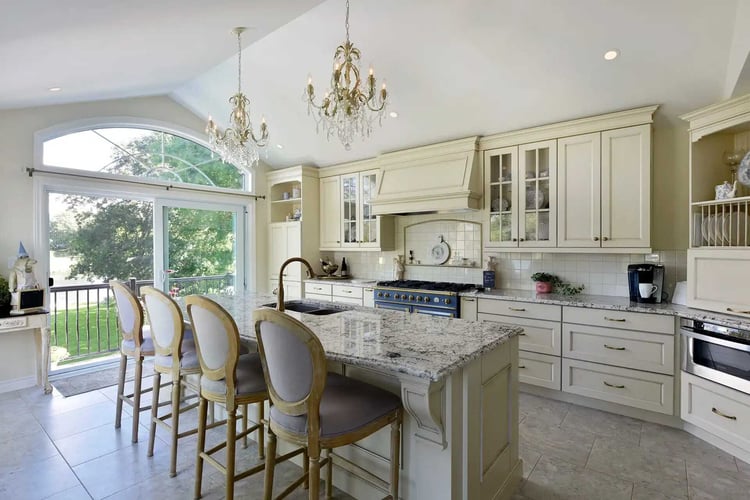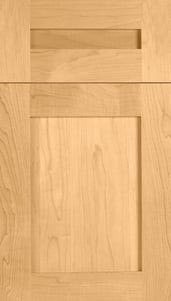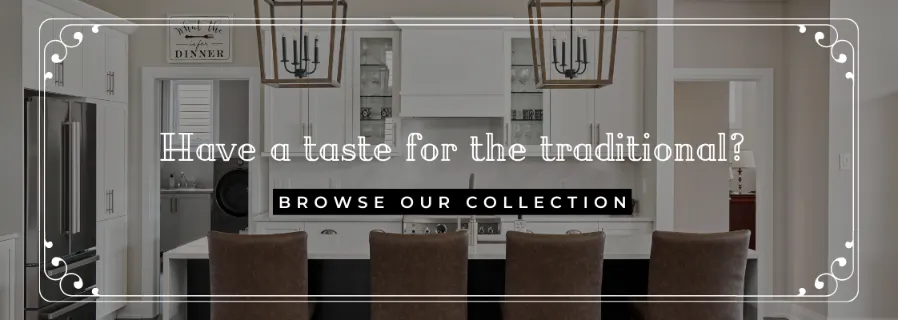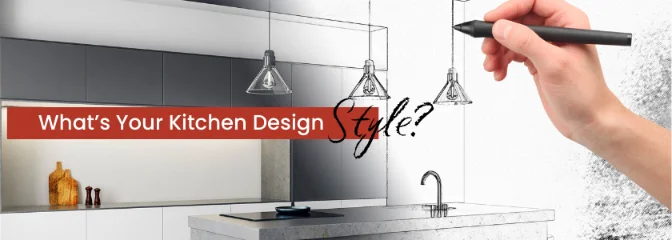17/04/2023 • Blog, Comparisons, Design Tips
Kitchen Design Styles: Traditional vs. Transitional
Estimated Read Time: 6 Minutes
It’s no wonder the kitchen is often considered the heart of the home. From cooking to eating meals and socializing, the kitchen is the most used room in the house.
But how or where do you even begin to start a kitchen design that fits your unique tastes and preferences? If you’re starting a new build or planning a renovation, knowing where to start with the kitchen design process will be invaluable.
Two long-standing kitchen design styles worthy of your consideration are traditional and transitional.
At Deslaurier, we have over 40 years of experience providing our clients with custom cabinets and kitchen design services. In that time, we’ve helped hand-craft hundreds of kitchens to cultivate a traditional or transitional design style.
With so many moving parts between the two, it can be difficult to know where one design style ends and the other begins.
In this article, we'll explore traditional and transitional kitchen designs, comparing their similarities and examining their key differences to help you determine if either style is right for your home.
Let’s get started!
|
Table of Contents |
|
What is Traditional Kitchen Design? What is Transitional Kitchen Design? Features in a Traditional Kitchen |
What is Traditional Kitchen Design?
What’s considered “contemporary” today won’t be the same a decade from now. Trends come and go, but the appeal of a traditional kitchen is timeless.
Traditional kitchens are on the opposite side of the design spectrum as modern kitchens. Where modern kitchens are streamlined and minimalistic, traditional kitchens are anything but.
Rather, traditional designs are chock-full of embellishments, detail, and decorative finishes that beg to be admired.
The great thing about traditional design is that it’s a general, broad term. A traditional space can pull styles from all places and time periods. As long as the item is ornate, unique, or vintage, it will probably fit into a traditional kitchen design.
What is Transitional Kitchen Design?
Transitional design is a harmonious blend of traditional and contemporary styles, resulting in a well-appointed hybrid that seamlessly combines old and new elements.
By pulling from both categories, this style achieves a balanced and sophisticated look that appeals to homeowners seeking a warm and welcoming atmosphere with some modern flair.
With a focus on clean lines, neutral colour palettes, and natural materials, transitional kitchens exude a sense of calm and simplicity, making them a popular choice for those seeking a relaxed yet elegant space.
When done correctly, mixing and matching traditional and modern elements is one of the best ways to create a fashion-forward transitional kitchen design.
Where They’re Similar
Since transitional kitchen design borrows from traditional design, it should be no surprise that the two styles have several qualities that overlap with one another. They both offer elegant and timeless characteristics with their own unique touch added on.
With sleek lines and sharp features, many transitional kitchens also incorporate crown moulding, farmhouse sinks, and elegant backsplashes. While they may not be as grandiose as their traditional counterparts, they’ll still include endearing decorative millwork and creative flair.
For instance, both styles love a statement range hood.
Range hoods are a key part of either kitchen style’s overall design. They are customized statement pieces, trimmed with colour, and detailed with unique shapes or clean lines.
Whether they’re bold and extravagant, or more subtle, custom range hoods are a key feature to make your kitchen stand out.
Expansive farmhouse (apron-front) sinks are also found in both schools of design. While traditional kitchens may prefer copper to transitional’s cast-iron, the style and functionality of farmhouse sinks is universal.
How They Differ
As we’ve mentioned, both styles can have decorative mouldings and ornamentation; but traditional kitchen designs are usually far more intricate than transitional ones.
In this day and age, traditional kitchen design can often run the risk of looking outdated and behind the times.
Countertops are typically a stark differentiator between the two styles. Traditional kitchens will include granite and marble, two of the most unique stone surfaces with extravagant natural veining and patterns.
They’ll go even further with profiled edges and a leathered finish to provide a textured surface that can accentuate the natural characteristics of the stone.
Conversely, transitional countertops are usually a bit more subdued. They feature quartz – as well as marble and granite – but with more subtle veining and lighter colours in white, cream, or soft grey.
Their countertops are typically smooth surfaces with minimal to no texturing and have rounded edges rather than detailed profiling.
The cabinet woods the two design styles use are often chosen for different qualities, as well. Traditional kitchen cabinets incorporate pronounced wood species with deeper, more colourful hues. Classic woods like oak, cherry, or even mahogany are commonplace and often used with a prominent stain.
Transitional cabinets, on the other hand, opt for gentler, lighter wood species. Birch and maple are popular cabinet woods, as well as the more contemporary white oak. They’re typically adorned with softer finishes to retain the natural, lighter colour of the wood.
Features in a Traditional Kitchen
Perhaps the most telltale indicator of a traditional kitchen is the style of cabinetry used.
Recessed and raised panel doors tend to be first in line for traditional kitchen lovers. They almost always include intricate detailing and added dimensions that emanate class.
.png?width=750&height=407&name=Traditional%20Door%20Styles%20Edited%20(1).png)
Arched or cathedral door styles add even more character and “heaviness” to increase the decorative look and traditional sensibilities.
And it doesn’t stop there. Traditional kitchen cabinets pair beautifully with ornate, embellished millwork such as crown moulding and decorative trim.
Not enough flair for you? Add a kitchen island!
In traditional kitchen designs, central islands aren’t just a functional element of the kitchen, they’re also a primary design statement.
Just see for yourself:

Traditional islands will almost always include columns and corbels to support countertop overhangs. That’s not unusual in itself, but these elements are often highlighted with some of the most decorative, ornamental pieces of trim in the entire home!
Features in a Transitional Kitchen
Transitional kitchens encompass an airy and casual atmosphere that draws you in with their warmth and simplicity.
Shaker doors are the quintessential transitional kitchen cabinet door style. They have the ability to be included in almost any kitchen design. The stiles and rails can be sleek and narrow for a more modern door, or wider to contribute to a more traditional cabinet.
Our “Brookfield” shaker door embodies transitional design to a tee, and also happens to be our best-selling cabinet door style!

Transitional cabinetry is typically kept simple, with a streamlined and subdued appearance. Classic shaker-style doors are great for that clean look. Usually, transitional cabinets have very little decorative detail, with not much more detailing than simple applied moulding on the interior of the frame.
Similar to the cabinetry, transitional hardware should be minimal and modest to complement the cabinetry design. Simple knobs and handles in matte black, gold, or silver finishes do just the trick to create an uncomplicated finishing touch.
Another key feature of transitional kitchens is their openness. They often include floating shelving to open up the upper walls so they’re not overwhelmed with a heavy cabinetry look.
Expansive lighting – especially natural lighting – also plays a big factor. It adds to that feeling of openness and brightens up the space.
What Design Style is Right For You?
If you want a statement kitchen that’s sure to catch the eye, nothing quite does it like the detailed ornamentation of traditional design. From the millwork to the countertops, traditional kitchen design will never be accused of being boring.
If you’d rather have a more updated, contemporary kitchen, opting for a transitional style might suit you better.
It allows you to bring more subdued features to your space, with a sense of modernity and simplicity to the elements you include, while still achieving that warm and welcoming atmosphere that strictly modern design style often lacks.
The added benefit of transitional design is the ability to include your favourite traditional-style features while not being restricted to a completely traditional kitchen. Throwing in a show-stopping range hood with custom millwork is always encouraged!
Ultimately, choosing a kitchen design will always come down to your lifestyle, design preferences, and budget. Consider these accordingly and you’ll be able to craft the perfect kitchen design to fit your home!
Design with Deslaurier Custom Cabinets
In the world of kitchen design, traditional and transitional styles may seem like two peas in a pod. However, we hope this article has helped you to appreciate the subtle yet significant differences between them. Armed with this knowledge, you can confidently select the style that best suits your taste and personality.
If you’re looking to install the perfect custom cabinets in your dream kitchen, Deslaurier Custom Cabinets has everything you need! With over 40 years of experience in our name, we provide our clients with a fully customized design process with our talented team of designers.
Book a consultation today with a Deslaurier design expert at our Ottawa Showroom or schedule a virtual meeting!
Live outside the area? Find a Dealer to connect with near you! Interested in becoming an authorized Deslaurier dealer? Visit our Become a Dealer page to learn more!
.png?width=224&height=80&name=Final%20(3).png)


